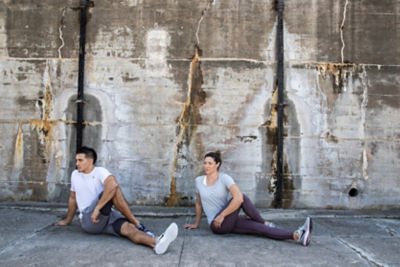Different Ways to Carry Your Gear on a Run
We’re breaking down the best options to store the essentials on your next run.
Whether you’re on an everyday run around the neighborhood or park, or toeing the line on race day, you could be carrying a variety of running essentials, such as a water bottle, gels, protein bars, cash, ID, your smartphone and more. The question is: how are you managing all that?
Thankfully, there are a variety of options to suit your workout or race-day needs, so let’s get up to speed. Discover some popular packing solutions with help from our DICK’S Sporting Goods Run Ambassadors in these Pro Tips.
WHAT TO BRING
Your planned distance can affect how much gear you need to bring on your run. While longer runs may call for additional gear like a water bottle and snacks, these may not be necessary for shorter jogs. Run Ambassador Amy Adkins says a good rule of thumb is to take your personal needs into consideration and remember added gear means added weight.
“The lighter, the better,” Adkins says, “Don’t take everything you possibly can take. Try and reduce the amount of things you’re taking to just what you absolutely need.”
POCKETED APPAREL
One of the simplest, most natural ways to carry your gear on a run is in your pockets. Most pockets provide enough space to carry necessary items like a phone, wallet or set of keys. Your items are always within reach, and there’s no added equipment you need to remember for your run, too.
One of the downfalls of carrying your necessities in your apparel pockets, however, is the potential for lost items. The constant movement can jostle your items up and down as you stride, potentially bouncing them out of place. To combat this, Adkins says she looks for a simple feature when choosing running apparel.
“Generally, for me, I like something that has a zipper pocket, because if you’re bouncing, things have a way of moving up and falling out,” she says.
The added security of a zippered pocket can help keep your gear locked in storage. You can run with confidence knowing your necessities will still be there when you’ve completed your route.
POUCHES
The largest of the carrying accessories, pouches, also referred to as waist packs, often include a place to stash your phone, room for extra gels and bars, and even a pocket for IDs and debit cards. They come in multiple styles, from the resurging fanny pack to a smaller pouch that’s hooked to a thin belt. For an added touch, many designs have an outside pocket for water bottles, giving you easy access to refreshment on the move.
Pouches can make excellent companions for exceptionally long runs, races or marathons. With a world of tools just a zipper away, a full-size pouch is designed to carry a lot.
On the flip side, pouches tend to be the most cumbersome form of carrying running gear and could be heavier and more difficult to manage over long distances.
Minimize that by choosing a sleek and small model, or simply shift strategies by choosing a different carry option.
BELTS
For anyone looking for a compromise between comfort and carrying ability, a slim belt may be the way to go. You can find belts that have expandable, zipper pockets that you can slide your ID or phone into, plus a few other items. You don’t want your stuff falling out during your run, so belts with zippers are a great option. If you use a belt, though, stick to bringing the essentials so you’ll have room for the most necessary of items.
But don’t sell belts short. According to Cathy Connor, a DICK’S Sporting Goods Associate who has run almost 30 marathons, gear belts can allow you to carry quite a few things, including pepper spray “if you’re in unfamiliar territory” and a house or car key.
This is a good option for comfort, designed to be lightweight and with significantly less bounce than a pouch model. Advanced options include reflective accents, dividers to hold gels/fuel, and a quick-release buckle.
Another useful option is a hydration belt, which typically includes gear pockets to hold smaller running essentials, but also allows you to carry water bottles on your person, sometimes as many as four at a time.
ARMBANDS
Armbands are exactly what they sound like — pouches on a band that loop around your arm rather than your waist. They’re an excellent choice for runners who want something smaller and less bulky, and would like quick and easy access to their phone in order to change a song on the playlist, or take a quick call.
More advanced options include pockets for other items, too, like a few bucks and an ID. Look for bands with adjustable length to ensure it will fit you.
Some people, like Cathy, our marathon veteran, may forgo more modern technologies and use smaller clip-on MP3 players for their entertainment, making armbands less necessary. That’s when we get to the real minimalists.
JUST WATER
If you want to keep it really simple, you could try lacing a house or car key to your shoes and just carry your water. If you take this approach, look for a handheld water bottle specifically designed for running. These feature an ergonomic hand strap that offers a grip-free running experience. That way, when you give it your best in that last kick toward the end of your run, your hand and arms should feel relaxed, not tense.
Whether you’re going on an evening run or it’s time for race day, the gear you need — and how you carry it — comes down to personal comfort and needs. Think carefully through the pros and cons of each option and you’ll be able to choose a carrying accessory that can act as an ideal partner from start to finish.








